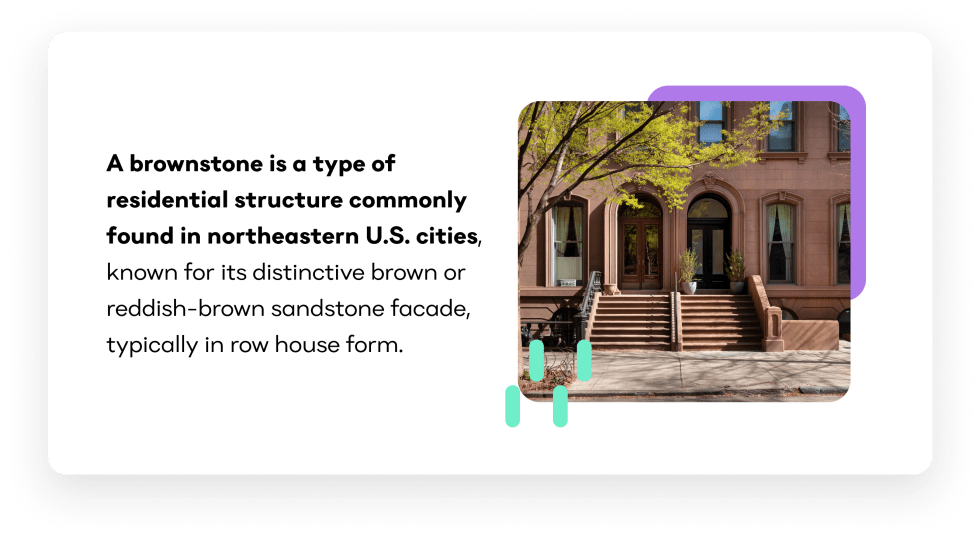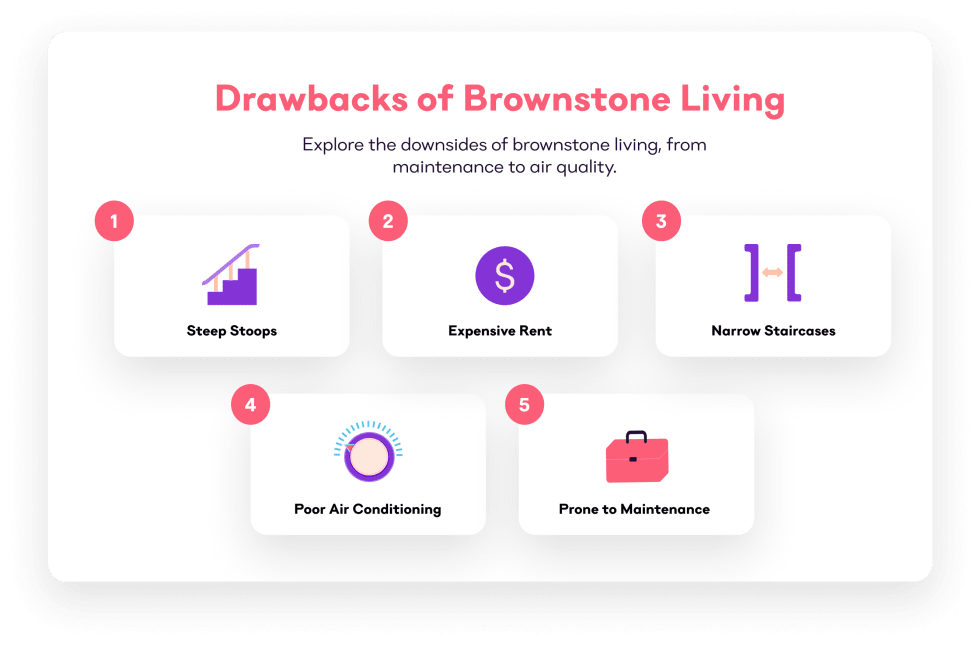South Bank at Quarry Trails
- 91 units available
- Studio • 1 bed • 2 bed • 3 bed
- Amenities
In unit laundry, Patio / balcony, Granite counters, Pet friendly, Stainless steel, Walk in closets + more

If you've ever visited New York City or Boston, you've probably strolled past the cozy, sandstone brownstones with ornate facades that line the city streets. These tall dwellings look similar to townhouses and are usually connected to other brownstones in a long row. Despite its muted brown color, brownstones are typically regal looking and are wildly popular throughout New England and some other areas of the country.
Like a house, brownstones could serve as an entire dwelling with multiple floors and a backyard area. Many brownstones were converted into multi-family buildings with individual apartment units on different floors. It's also common to see the bottom floor rented out as a smaller apartment, like a studio, while the landlord occupies the rest of the building upstairs. Get started by checking out this tour of a real brownstone from Open House TV and then scrolling on to our guide:
A brownstone is a type of residential building named after the brown sandstone used to construct single-family homes throughout the early 19th century. Brownstones were often row houses consisting of two to four floors found in major Northeastern cities like New York, Boston, and Philadelphia. Until the 1800s, brownstone material wasn't that desirable and proved cheaper to build with than its alternatives. However, brownstone became highly popular during the Romantic era due to its natural look.
While hundreds of brownstones were quickly built throughout Manhattan, Brooklyn, and other areas of the Northeast, they are no longer being built today. The result is a low supply and high demand for brownstones, which drives up the rental prices.

When it comes down to it, a big reason brownstones are so popular is their iconic associations with the cities that they are found in. Many people dream about living in the brownstones they see in New York City as its portrayed in movies and TV shows. However, besides their renown and scarcity, there are several key reasons why brownstones are so desirable (and that explain why prices are so high):
Brownstone neighborhoods are usually iconic areas to live in. You'll discover specific neighborhoods, including New York City's Upper West Side, Brooklyn Heights, and Park Slope, with the most brownstones in the city. You'll also find urban amenities, pubs, restaurants, good schools nearby, and even commercial establishments operating inside brownstones.
If you can afford the high cost of renting a brownstone, then you'll get to enjoy plenty of space in its units. Instead of small, choppy apartments, most brownstone apartments span the entire first, second, or third floors. Smaller apartments are usually found on the ground floor or street level and may prove cheaper than higher floors with views.
Brownstones were originally single-family homes with small yards included in the design. The yards are much smaller than a suburban property but are still spacious enough to enjoy the outdoors or add patio furniture. Sometimes a landlord will limit outdoor access to renters and only offer a specific area for private use.
Brownstones are celebrated for their ornate detail inside and out. It's not uncommon to find carved, wooden mantels inside a brownstone, old wooden floors, and stained glass window touches. If you're not a fan of templated apartments with the same layout over and over, brownstones are dazzling in comparison.
Brownstones are relatively rare compared to dwellings in the rest of the country and represent an iconic symbol of city living. Many people move "back east" with dreams of brownstone living in mind where they sit on their stoops, watch the sunset, and chat with neighbors.

Besides the obvious downside of scarcity, here are some of the biggest drawbacks to brownstone living:
Some people love the look of brownstone stoops, but they're very steep and can get slippery during rain and ice. The concept originated from the Dutch word "stoep," or step. Stoops were added to buildings and brownstones to raise the main parlor floor above floodwaters. However, some argue that the original stops were also built to keep the main floor above a "sea of horse manure."
Sure, you can avoid all kinds of undesirable activity with your brownstone stoop. However, they can be challenging to climb, especially with heavy suitcases and groceries.
Rent is already high in areas like New York City and Boston, but brownstones are in a whole different category. The lack of inventory and high demand drives up the prices and can scare away new renters on a budget. Sometimes brownstones can be found scattered in less desirable neighborhoods that make single apartment units inside more affordable. It’s also possible to score a rent deal for a brownstone apartment even in New York City.
Brownstone dwellers know they have to measure furniture before buying it and moving it indoors. Brownstone staircases are narrow, old, and aren't friendly to oversized couches and bed frames. You'll need furniture specifically designed for smaller spaces that fit well in urban settings.
The oldest brownstones date back to the 1800s, and although they've undergone renovations, the buildings are still old. Brownstone material is porous and needs ongoing maintenance, which can be disruptive for renters. Inside structures, plumbing, electrical, windows, and ceilings are also prone to maintenance and upkeep.
Due to the expense of updating a century-old building, landlords aren't eager to install any type of air conditioning system in brownstones. As a result, most of the apartments in New York City and other historic New England cities rely on window AC units instead. However, sometimes brownstone windows can't accommodate the addition or limit your options for where you can place them to stay cool during hot, humid summers.

Many people use the terms "townhouse" and "row house" interchangeably with brownstones, but there are differences. Brownstones look similar to their counterparts but are made from brick and outfitted with a brownstone facade. Townhouses can also be older, but are not associated with the time period and materials of traditional brownstones.
Townhouses are usually single dwellings for an owner or renter. However, brownstones are frequently converted into multiple apartment units, which could feel like a loss of privacy compared to townhouse living.
Brownstones are a popular, iconic, and spacious place to live. However, there are some downsides like expense and the potential for more maintenance and renovations. Whatever you decide, make sure you pick a great neighborhood with all the amenities you're looking for to enjoy city living.
If you're looking for apartments in the Northeast, try our easy quiz to get matched with great amenities in your ideal location and price point. If you're looking in the Northeast, keep an eye out for brownstones in high-end neighborhoods!


In unit laundry, Patio / balcony, Granite counters, Pet friendly, Stainless steel, Walk in closets + more
In unit laundry, Hardwood floors, Dishwasher, 24hr maintenance, Stainless steel, Walk in closets + more